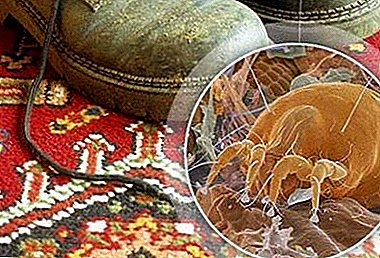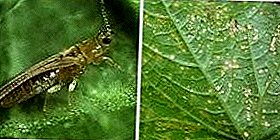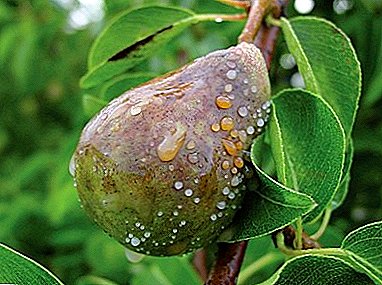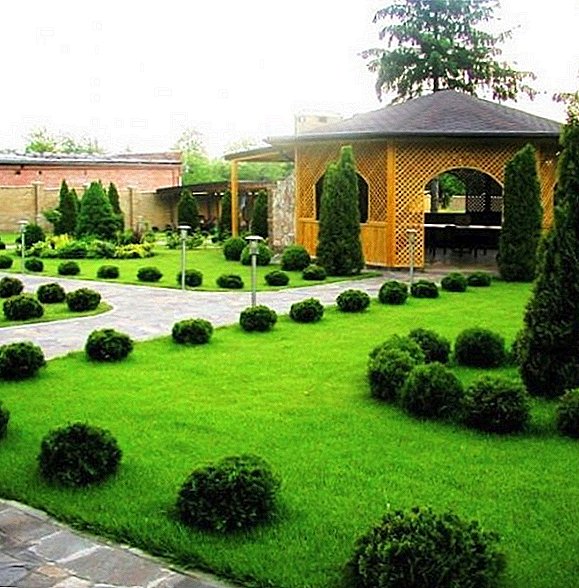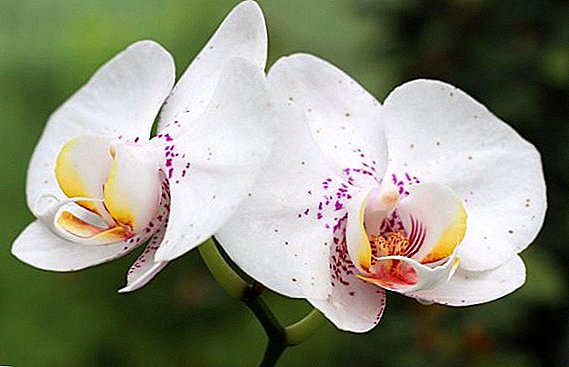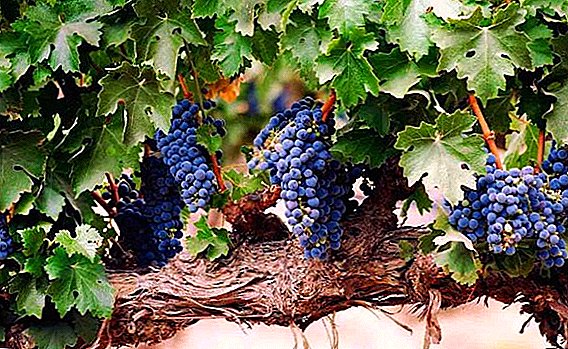 Grapes are a common plant in many countries of the world, but wherever it grows, it needs special care, as there are many diseases to which the grapes have no immunity.
Grapes are a common plant in many countries of the world, but wherever it grows, it needs special care, as there are many diseases to which the grapes have no immunity.
Therefore, we consider one of the diseases that grapes are prone to - chlorosis.
What is chlorosis and how is it dangerous?
Chlorosis is a disease in plants, which is characterized by a lack of chlorophyll formation in the leaves and a decrease in the production of photosynthesis. The most common is chlorosis grapes. Young leaves become yellow, old - and lose it at all. They can curl and fall. Every day the yellowing can become more intense. Shoots stop in development. The ovary of the fruit showered, new shoots die off. By the end of summer, immature grape bushes die.
Causes and signs of the disease
Chlorosis is affected by weather conditions. Dry and warm weather is more beneficial than wet and rainy.
Check out such grapes as "Arched", "Riesling", "Gourmet", "Elegant", "Tason", "Buffet", "In Memory of Domkovskoy", "Julian", "Chardonnay", "Laura", "Harold "," Gala "," Lily of the valley "," Kesha "," Chameleon "," Ruslan ".The analyzed disease is dangerous by drying and scattering, yellowing of the leaves, stunted growth of the shoots that do not change the thickness and length. Observed acquisition leaves brown color, drying and falling off.
Damaged grape bushes appear looseness of clusters and small fruits, which leads to a decrease in yield. 
Non-infectious
In other words, functional or iron chlorosis occurs due to unbalanced saturation of grapes with iron, manganese, cobalt, copper, zinc, molybdenum, which are concentrated in the soil and are poorly soluble compounds.
That is, the grapes can get sick not necessarily because of the absence of these chemicals in the soil, but because of their poor solubility in the plant.
This type of disease can be identified by the yellowing of the leaves near the veins, the cessation of the growth of the plant, or its directionality in the lower part of the bush. It occurs when an unbalanced metabolism, an excess of lime and moisture in the soil, reactions with alkali in the soil, lack of iron. If most of the chlorophyll dies, the plant feels fasting. We can determine this by stopping in growth, withering of leaves and shoots, shedding of clusters and flowers. If you do not provide assistance, the plant may die.
Important! The described symptoms are characteristic only for chlorosis caused by iron deficiency.
Infectious
Other names for this viral type of disease are yellow mosaic, panashyur. Viruses, microorganisms and fungi can cause infectious chlorosis. It is transmitted through plant pests, soil, or planting material that has come into contact with a diseased plant. At a temperature of 58-62 ° C, the virus dies.
In spring, the symptoms may be the yellow color of the leaves or other parts of the grapes. After some time, the leaves become green in color with unpainted spots, randomly scattered around the plant. On the bushes shoots change their shape, and clusters become small.  Because of the severity of the disease, it is better to root out the bushes, since they will not bear fruit, but there is a danger of infecting other plants. The geography of distribution is Europe, Argentina, California, southern Moldova, Uzbekistan, and Tajikistan.
Because of the severity of the disease, it is better to root out the bushes, since they will not bear fruit, but there is a danger of infecting other plants. The geography of distribution is Europe, Argentina, California, southern Moldova, Uzbekistan, and Tajikistan.
Carbonate
Another name is a limy type of disease, which is the most common. Occurs on grapes, which grows on dense soil with poor gas exchange and carbonate and alkali saturability.
Carbonate chlorosis is most often local. Chlorosis with an excess of lime is caused by a low concentration of iron. Therefore, plants with low levels of iron lose their green color due to their inability to produce chlorophyll.  Iron is in the soil in sufficient quantities, but due to being in the form of hydroxide, it does not reach the plant well. Similar characteristics have copper, manganese, zinc salts, which in the tissues of the plant acquire inactive forms. Carbonate form of the disease can cause drying and death of grapes.
Iron is in the soil in sufficient quantities, but due to being in the form of hydroxide, it does not reach the plant well. Similar characteristics have copper, manganese, zinc salts, which in the tissues of the plant acquire inactive forms. Carbonate form of the disease can cause drying and death of grapes.
Prevention
If you saw the first signs of chlorosis on the grapes, but you still have healthy bushes, the best thing that experts advise in this case is to take preventive measures:
- improve soil conditions (air and water permeability of the soil) by drainage, adding expanded clay, slag or rubble;
- limit manure of the vineyard, as it can, in conjunction with lime, enhance its negative properties;
Did you know? The most useful natural fertilizer is considered to be compost and peat.
- more suitable mineral fertilizers that reduce the concentration of alkali in the soil (potassium sulfate, ammonium sulfate);
- it is recommended to sow lupine or alfalfa near the grapes to saturate the soil with microelements and establish hydro-exchange and gas exchange;
- lay near the vineyard land that does not contain lime. This event should be made when planting plants.

How to deal with chlorosis
If you notice chlorosis in grapes, you should familiarize yourself with the features of different types of this disease in order to choose the right advice for you on how to properly treat it. First of all, it is necessary to determine the reasons for its appearance. After that, it will be easier to choose one of the possible ways to get rid of it.
Learn how to transplant grapes, how to feed, how to graze, how to plant, how to make wine at home, how to cut the grapes.
Non-infectious
It is necessary to feed the leaves with iron chelate. As well as chlorosis grapes can be cured with iron sulfate, which should be treated root. A balanced top dressing with manganese, boron, magnesium, and zinc will also be beneficial.
There are other recommendations on how effectively chlorosis of grape leaves can be treated. Spraying the leaves will be an effective way.  To do this, you need to make a solution, which includes 700 g of ferrous sulphate, 100 liters of water that does not contain lime, 1 kg per 100 liters of water from a well that is rich in lime. If you add citric acid in a volume of 100 g per 100 liters of water, the efficiency of the procedure will increase, but its cost will increase.
To do this, you need to make a solution, which includes 700 g of ferrous sulphate, 100 liters of water that does not contain lime, 1 kg per 100 liters of water from a well that is rich in lime. If you add citric acid in a volume of 100 g per 100 liters of water, the efficiency of the procedure will increase, but its cost will increase.
Important! In no case can this solution be mixed with iron sulfate.It is necessary to spray early in the spring 2-4 times with an interval of 3-5 days. A more noticeable result will be if the leaves are young and less stained.
For greater effectiveness of the drug, spray in the evening or early morning. There are restrictions: 700-800 liters per 1 hectare. Also, spraying should be avoided during the flowering period of the grapes. 
Infectious
Since this type of disease is caused by viruses, microorganisms or fungi, the listed organisms, as well as sucking insects (thrips, aphids, spider mites) that tolerate chlorosis, should be destroyed.
You must also ensure that the planting material does not touch the diseased plant. In the worst case, the bushes should be removed, that is, completely uprooted and burned.
In order to prevent the spread of the disease, the use of inoculum taken from the focus of the disease should be avoided. Uterine vines need to be placed in areas not contaminated with chlorosis.
Did you know? For the first time infectious chlorosis was investigated and described in 1937 in Czechoslovakia.If the bushes in the rootstock vines have already become infected, they are uprooted and the land is treated with dichloroethane to destroy the insects living there.

Carbonate
It is necessary to feed the leaves with iron chelate, and it is better to process the roots with ferric acid iron or to use vitriol with citric acid, which will promote slow oxidation.
For the treatment of chlorosis, grapes can be treated with 0.1% iron sulphate (10 g per 10 liters of water). It is recommended to repeat the procedure if necessary (with repeated signs).
It will also be useful for you to learn about such diseases and pests of grapes as mildew, grape mite, oidium.In autumn or at the end of winter, it is possible to make ditches along the perimeter of the bushes and add 150-400 g of the solution with iron sulfate to the soil, cover it with earth.
Another way to cure the carbonate form of the disease is the use of micronutrients, which allow you to resume optimal metabolism and photosynthesis. These are iron complexones containing organic matter.  The most common fertilizers (complexes with metallic chemical elements) of this type are complexonates.
The most common fertilizers (complexes with metallic chemical elements) of this type are complexonates.
Resistant varieties
There are varieties of grapes that do not suffer from chlorosis or are more resistant to it. European varieties "Vitis vinifera" (Vitis vinifera) are more resistant than "Vitis labruska" (Vitis labrusa), "Vitis riparia" (Vitis riparia), "Vitis rupesteris" (Vitis rupestris), common in America.
Among the South American varieties, Vitis berlandieri (Vitis berlandieri) is considered the most stable because of the sufficient level of carbonate in the soil.
European varieties "Shasla", "Pinot", "Cabernet-Sauvignon" are recognized as the most stable in their geographic latitudes. But, despite the advantages of these varieties, they still have drawbacks. For example, grape varieties in Europe are more resistant to carbonate soil, but can die from phylloxera.  American varieties, on the contrary, are resistant to phylloxera, but the calcium content in the soil leads to their death. Therefore, it should be remembered that for each grade there is a permissible level of calcium in the soil and individual resistance to phylloxera.
American varieties, on the contrary, are resistant to phylloxera, but the calcium content in the soil leads to their death. Therefore, it should be remembered that for each grade there is a permissible level of calcium in the soil and individual resistance to phylloxera.
Among the unnamed varieties are less susceptible to diseases "Trollinger", "Limberger", "Portugizer", "Elbling", "Cabernet", varieties "Saint Laurent" and "Muscatel".
As we have seen, chlorosis is a dangerous disease for grapes, since in the absence of proper conditions and preventive measures, the plant can hurt or dry for a long time.
It should be remembered that each type of disease analyzed requires its own approach to grapes and it is impossible to apply preparations for one type to another in order not to worsen the condition of the plant. For greater comfort, the gardener is offered a wide range of resistant varieties.



